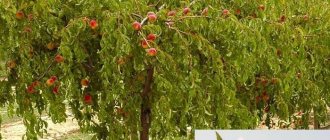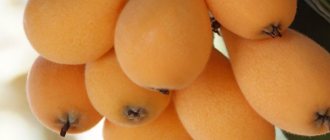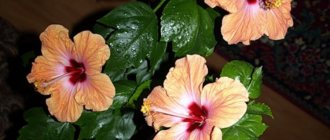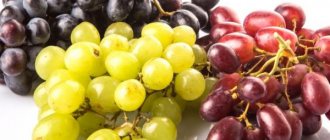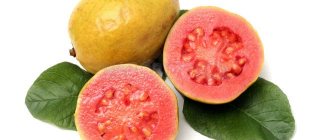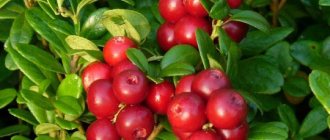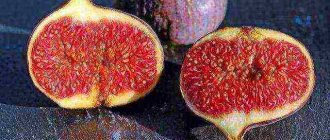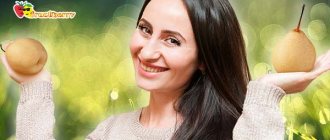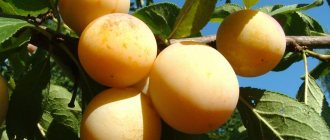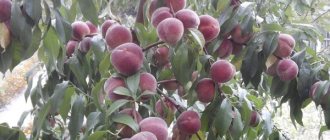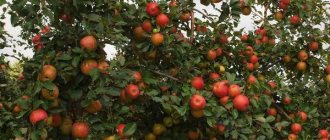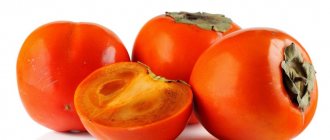Hello!
This fruit is made of delusions. First, the fig peach is in no way related to the fig, since even in theory, the peach and fig are not capable of interbreeding. So figs will attract attention to the name of this species only due to its flattened shape. And, secondly, contrary to its name, it has nothing to do with Persia, since it comes from China. However, all these absurdities in no way detract from the merits of the fig peach, which is tasty and healthy for almost everyone, which will be discussed further.
What makes the fig peach unique?
Fig peach has a unique chemical composition, thanks to which it has a powerful preventive effect. Even the smell of this low-calorie fruit is beneficial - it relieves depression.
Fruit composition:
- Organic acids.
- Essential oils.
- Pectin.
- Micro- and macroelements (potassium, sodium, calcium, phosphorus, sulfur, magnesium, chlorine, copper, iron, zinc, fluorine, chromium, manganese).
- Vitamins: C – strengthens the immune system;
- H – participates in carbohydrate metabolism;
- E – has an antioxidant effect, participates in cell regeneration;
- K – promotes liver function, strengthens capillaries;
- beta-carotene – is a preventive agent for cancer;
- B vitamins - normalize the functioning of the nervous and cardiovascular systems, strengthen the immune system, improve intestinal function and emotional state.
Calorie content of fig peaches: 100 g – 60 kcal. 100 g of peaches contain:
- proteins – 1 g;
- carbohydrates – 14 g;
- fat – 0 g.
Fig peaches are contraindicated for diabetics and those who are allergic to Pink fruits.
Chemical composition and calorie content
Peach figs are very healthy. This is facilitated by the rich composition of the fruit.
- Fig peach fruits contain many macro- and microelements. They contain a lot of sodium, potassium, and phosphorus. Fruits are saturated with calcium, chlorine, and sulfur. Magnesium, iron, zinc, copper are present in the pulp of the Chinese turnip. There is fluorine, manganese, chromium here.
- Flat fruits are a real vitamin cocktail. Vitamin group B, ascorbic acid (C), alpha-tecopherol (E), biotin (H), lipophilic and hydrophobic vitamins (group K) are found in the fruit. The fruits are enriched with beta-carotene.
Fig peach has a low calorie content, although the fruit tastes sweet. 60 kilocalories per hundred grams of fruit - this is the average. Therefore, fruits are included in the diet.
General description of the variety
The fig peach is easily recognized by its unusual shape. Unlike other varieties of peaches, it has not spherical, but flattened fruits, similar to either a fig or a turnip. This peach has no botanical relationship with figs, but it has many interesting and memorable names - Fergana, saucer, Chinese turnip.
In some European countries, the fig peach is called a “doughnut” - for the round depression that remains in the middle of the fruit after removing the pit.
Brief botanical description:
- Tree. Reaches a height of 5 m. The crown is spreading.
- Leaves. Lanceolate in shape. The upper surface is dark green, the lower surface is grayish.
- Flowers. Petals are pale pink. They look like wild roses.
- Fruit. Flat shape. The skin is not as hairy as regular peaches. The bone is small. The color depends on the variety; there are fruits in yellow and orange shades. Everyone has a red blush. Weight – 100-200 g. Diameter – up to 7 cm.
Fig peaches have important advantages over regular ones:
- Ordinary peaches have flesh; the closer to the pit, the less intense its taste. Fig varieties do not have this - the taste is the same in any part of the fruit.
- Has greater frost resistance.
- The stone is smaller - only 3-4 g.
Fig peach: description and characteristics of the variety, beneficial and harmful properties, photo
Fig peach attracts owners of summer cottages and personal plots with the unusual shape and taste of the fruit, as well as increased frost resistance compared to ordinary peach trees. Since caring for this plant requires increased attention, growing it requires certain knowledge.
History of the origin of the Fig Peach
Fig peach can often be found under other names - Chinese turnip, Flat, Paraguayan. Interest in it is explained by the unusual shape of the fruit - they are flattened, similar to donuts.
Contrary to popular belief, the Fig Peach is not a peach-fig hybrid. It is obtained from wild varieties of peach trees growing in Central Asia.
Description and characteristics of Fig peach
The tree of the described variety is tall - it can reach a height of up to 5 m. It has a spreading crown. The annual increase is small.
The leaves of the Fig Peach are lanceolate, with a dark green upper plate and a gray lower leaf. Flowering occurs in mid-April. The flowers are similar in appearance to those that appear on rose hips. They are pale pink in color.
The fruit ripens in July - August. The diameter of the fruit reaches 5–7 cm. The average weight of one piece is 100–150 g. The fruits are covered with a dense, pubescent skin. Its color can vary from yellow to red, depending on the variety. The pulp is characterized by high taste characteristics and juiciness.
Fruits are grown for fresh consumption, use in various culinary dishes, desserts, and canning.
- Fig peach has a number of advantages:
- high taste and unusual shape of the fruit;
- small bone;
- ability to tolerate transportation well;
- high level of frost resistance;
- persistent immunity.
- Among the disadvantages it is worth mentioning:
- tendency to be affected by gray rot;
- Not long shelf life of fruits.
Beneficial and harmful properties of Fig peaches
Fig peach is considered a very healthy fruit due to its rich chemical composition. It contains vitamins A, C, E, PP, H, group B, beta-carotene, as well as minerals: sodium, potassium, phosphorus, magnesium, calcium, iodine, fluorine, zinc, iron, etc.
- When consumed regularly, the described fruit can produce the following positive effects on the human body:
- replenishes vitamins and minerals;
- cleanses the intestines;
- strengthens the immune system;
- normalizes the activity of the nervous system;
- prevents the development of cancer, heart and vascular diseases, anemia, vitamin deficiency, obesity;
- improves metabolism;
- has a beneficial effect on the functioning of the gastrointestinal tract;
- improves sperm quality;
- enhances lactation.
A fruit can have both benefits and harm, but its harmful properties appear only when eaten excessively, or if a person has an individual intolerance. Peaches should not be eaten by people diagnosed with diabetes or allergies.
The best varieties of Fig peach
The most popular varieties are UFO-3, Saturn, Vladimir, Belmondo, Kolonovidny, Nikitsky. Get to know some of them better.
Learn about the health and health benefits of peach.
Columnar fig peach
Columnar peach is valuable because it has a compact crown and takes up little space on the site . The trees grow up to 2 m in height.
The first harvest can be harvested in the second or third year after planting the seedling in the ground. The fruits appear in July - August. Average weight is 150–170 g. They taste sweet and juicy. Their stone is small - 3-4 g.
Transportability is low. Productivity - 6–10 kg per plant.
The main advantages of the variety are self-pollination and a high level of frost resistance (up to -30°C). It is suitable for growing in warm regions and areas belonging to the middle zone. It is possible to cultivate trees in containers.
Nikitsky
The trees grow medium in height, with a spreading crown. In August they bear large, slightly pubescent yellow fruits with a burgundy outer color. The inside is creamy and distinguished by its sweetness, aroma, and juiciness. The stone is small and can be separated from the pulp without any problems.
Nikitsky peaches are valued due to their high fertility, ease of care, tasty fruits, and ability to tolerate low temperatures.
Growing Fig Peach
To successfully grow a tree, you need to select and prepare a suitable place for it, purchase a high-quality seedling and comply with the deadlines and technology.
Site selection and soil preparation
Abundant harvests are possible only if the seedling is planted in a well-lit area, sheltered from the winds. Groundwater should not lie close to it. The optimal level of occurrence is no closer than 1.5 m to the surface of the earth.
Important! Flat peach produces the best yields when grown in black soil or loam.
Preparing the site and digging a hole must be done in the autumn. The hole needs to be made 60 cm wide and 50 cm deep.
The soil that was removed when digging a hole must be fertilized with mineral and organic fertilizers. One of the options for the nutrient mixture: organic fertilizers (2 buckets) + wood ash (1 l) + superphosphate (1 tbsp.
) + potassium sulfate (0.5 tbsp.). When planting in autumn, the last component should be replaced with potassium chloride.
Choosing a quality seedling
The purchase of planting material must be carried out in a specialized store or a well-established nursery. It is better to take one- or two-year-old seedlings - older specimens will take too long to adapt to new conditions.
As for the timing of planting, it is better to plant a heat-loving peach in April, making sure that there will be no more frosts and that the weather is consistently warm outside. It is important to have time to place the plant in the ground before it enters the growing season. If planted in spring, the tree will be able to adapt well to winter and successfully withstand low temperatures.
https://www.youtube.com/watch?v=gswTm85aFIY
Learn about the properties of dried peach.
Autumn planting can only be done in regions with a warm climate. Optimal time: end of September - first half of October.
Fig peach planting scheme
When planting a seedling, the following steps should be taken:
- Drive a planting stake into the hole.
- Place a drainage layer of crushed stone, gravel, and broken brick on the bottom.
- Pour the soil into a mound, filling 2/3 of the hole.
- Place the seedling on the hill, distributing the roots evenly. The root collar should rise 5 cm above the soil level.
- Fill the hole with earth to the top.
- Dig a watering circle in the near-trunk area, which will prevent water from spreading and falling directly under the trunk.
- Pour 20 liters of water into the circle.
- Tie the trunk to the stake.
- Place a layer of mulch in the tree trunk area.
If several trees are planted on a site, a distance of 3 m must be maintained between them. The recommended row spacing is 4-5 m.
Aftercare
Caring for a tree involves carrying out such procedures as watering, fertilizing, pruning, preventive treatments against diseases and harmful insects, and shelter for the winter.
Watering should be done 3-4 times per season. Recommended water consumption is 30–40 liters per plant.
Regular feeding should begin when the tree has been growing in the ground for 2 years . Complete mineral fertilizers should be applied annually, and organic fertilizers every 2-3 years.
For a plant that has not reached the age of 5 years, it is necessary to form a crown. In the second year after planting, you should cut off the branches, leaving 50 cm. The next year, you need to cut off last year's growth by a third.
After the crown has been formed, sanitary and maintenance pruning must be done every spring and autumn. During their course, all branches that show signs of disease, are damaged, withered, grow incorrectly, or are twisted are removed.
Each pruning procedure is completed by lubricating the cut areas with garden varnish or the “RanNet” preparation..
To prevent the peach from getting sick or being affected by harmful insects, it is necessary to resort to preventive measures. One of them is preventive treatments. They are produced 2–4 times per season: before buds open, along the green cone, in the bud extension phase, after flowering.
To prevent diseases, use Bordeaux mixture, “Zineb”, “Horus”, “Soon”, “Hom”, “Abiga-Peak”. Treatments against pests are carried out with Aktara, Karate Zeon, and Insegar.
In order for the heat-loving peach to successfully survive the winter, it is prepared for winter in a special way : it is pruned, whitened with a special solution, the trunk is insulated with pine spruce branches, spunbond, burlap, and the root system is insulated with a 20-centimeter layer of mulch.
How to grow fig peach from seed
In addition to growing from a seedling, flat figs can be grown from seeds . It should be warned that this process is not easy. In addition, during such cultivation the tree may not produce very tasty fruits. It is better to plant not in a container, but directly in open ground. It is advisable to do this in the fall.
To remove the seeds, only healthy fruits are selected that do not have spots on the skin or signs of rot.
The fruit is wrapped in a damp cloth and kept in such conditions for a week, after which the stone is removed, washed, inspected for defects and placed in a container with water for another week, adding fresh water daily. After drying, the seeds are ready for planting. They need to be split and the core removed.
For planting to be successful, it is recommended to plant not just one seed, but 10–20 at a distance of 5–10 cm from each other. The embedment depth should not be too large. After placing in the ground, the seeds should be sprinkled with a layer of leaves. Young shoots should appear in the spring.
Such trees begin to bear fruit in the second or third year . Caring for them is the same as for those plants that have grown from seedlings.
Tips for harvesting and storing crops
If peaches are planned to be consumed or processed immediately, they can be picked from the trees at full ripeness - when they are not very soft and juicy. If you plan to transport and long-term storage of fruits, then they need to be harvested in a slightly unripe form.
To remove a peach from a tree, you need to grab it with your palm, turn it a little, as if twisting it from a branch, and then gently pull it down. Fruits removed from the tree should be placed in plastic boxes.
Important! To avoid damage to the delicate skin of the flat peach, you must wear gloves when harvesting.
To ripen, the fruits can be laid out on a horizontal surface in a warm room, or packed in a paper bag along with an apple or banana. In room conditions, the fruits can be stored for up to 3 days, in the refrigerator for up to a week. They should be stored in a fruit tray, with each fruit wrapped in paper.
So, now you know what else the Fig Peach is called and that it is not crossed with figs, but grown from wild varieties of peach trees. In the countryside, you can grow it from a seedling or seed. To obtain an abundant and high-quality harvest, regular care is required.
Source: https://fermer.blog/bok/sad/plodovye-derevya/persik/sorta-persika/srednie-sorta-persika/7835-inzhirnye-persiki.html
What varieties are there?
All subspecies of fig peach are not only similar in shape and size, but also in agrotechnical characteristics; they are frost-resistant and tolerate return frosts well. Let's learn about the features of several of the most popular varieties.
UFO-3
Early ripening variety. Fruit weight is 100-120 g. The pulp is white. Almost the entire fruit is covered with a red blush, only here and there a pale yellow color is visible. The pubescence is very weak. The variety is winter-hardy, the fruits are resistant to cracking. Refers to industrial grades. The taste has honey notes.
The gardener provided a video review of the Ufo-3 variety of fig peach:
Nikitsky
This variety is considered the best for Russia. Suitable for harsh climates. The fruits are reddish in color and the flesh is creamy. Weight – 120 g.
Vladimir
A variety resistant to most peach diseases. The crown is medium spreading. The variety is resistant to frost. The color is pale yellow, the sides are red. Weight – 180 g.
Sweet Cup
The peculiarity of this variety is its early ripening. The fruits appear in 3-4 years. Fruiting - mid-August. Maturation is friendly. The taste is sweet and sour. The color of the skin is burgundy, the flesh is tender, white. Weight – 150 g.
Saturn
The plant is spreading, very beautiful, especially during the flowering period. The fruits are not very large - up to 100 g. When ripe, the fruits become yellow, with a light pink blush appearing on the sides. The variety is frost-resistant, the fruits are well transported. This is one of the most popular varieties among gardeners.
An overview of the Saturn fig peach can be seen in the video below:
Columnar peach “Fig”
The trees are low, with cylindrical crowns. The tree looks decorative. Fruits early. The fruits are deep red. Weight – 150 g.
Belmondo
The tree is not tall, the crown is spreading. Blooms later than other varieties. Ripening – second half of August. Very good dessert taste. Yellow fruits are decorated with a red blush. Weight – 120-140 g. Taste – delicate, pulp – juicy.
You can see the Belmondo fig peach in the video below:
Botanical description
Belonging to the Pink family, the fig peach belongs to the subgenus Almond, genus Plum. This is a cultigen that arose in the process of repeated introgressive hybridization - the most important factor in the evolution of fruit and berry plants. The appearance of the flat peach is due to the Hansuan peach, the amazing peach, the David peach, the common almond, the Chinese plum, the common apricot, and the cherry plum.
Fig peach is a plant that has many more characteristics of the almond tree than other related crops. The exception is fruits.
- An adult tree grows up to five meters.
- In an adult plant, the growth is small, the branches of the crown are widely spread in different directions.
- Annual shoots are colored red and have short internodes.
- The buds are large and heavily pubescent.
- Flower buds are arranged one at a time.
- The leaves are small, lanceolate-shaped. The top of the leaf is dark green, the bottom is gray-green.
- The flowering period is from mid-April. Fig peach flowers resemble rosehip flowers: large, pale pink.
- Disc-shaped fruits - peaches - are oblate, flattened or flattened. Their weight is from 90 to 100 g, in some varieties it reaches 120 g. The diameter of the fruit is 5-8 cm. The dense skin of the fruit is slightly pubescent. Its color can be yellow, orange, reddish, with transitions and different tones. A fresh blush is required on the fruit. The inside is creamy, yellowish, characterized by juiciness, fibrousness, a sweet-pleasant taste, and a delicate, barely perceptible aroma. The center of the fruit is occupied by a small flattened bone. Fruit ripening period is mid to late August. The keeping quality and transportability of fig peach fruits are low. In addition, the skin of the fruit often cracks. The fruits are consumed fresh, desserts and preparations in the form of compotes, jams, and preserves are prepared from them.
The plant has high frost resistance: it is not afraid of harsh winters and spring frosts. Warm to temperate climates are suitable for fig peach growth. The tree grows well in areas suitable for growing grapes.
In the central part of Russia, fig turnip fruits may not have time to ripen if summer temperatures are not high enough and long enough. The maturity and taste of fruits is negatively affected by the lack of sunny days.
How to plant a tree correctly?
The health of the future tree, its productivity and longevity depend on the correct planting of the fig peach and the quality of the planting material.
Site selection and soil preparation
Peach, like most fruit trees, is capricious, so when choosing a place to plant, you need to take its preferences into account. Site requirements:
- The optimal soil is chernozems and loams.
- Good sunlight. There should be no shadow from other trees.
- Wind protection.
- South side of the garden.
- Low level of groundwater – no less than 3 m.
If a shadow falls on a peach tree, its fruits will be tasteless or may not exist at all.
The soil is prepared in the fall - manure is added, and then it is covered with soil in a layer of 20 cm. There are two planting options:
- Spring. In this case, the hole for the seedling is prepared in the fall. Planting takes place in March.
- Autumn. The pit is prepared 2-3 weeks before planting. The seedlings are planted at the end of September or at the beginning of October.
In regions with a warm climate, peaches are planted in the fall; in regions with a harsher climate, in the spring.
It is not recommended to plant peach in areas where strawberries, melons, and nightshades grew. The place will be suitable for planting a peach only after 4 years, otherwise the tree runs the risk of getting verticillium.
Selecting a seedling and preparing it for planting
When purchasing a seedling, pay attention to a number of features:
- Region of acclimatization. It is necessary to choose varieties that are zoned in a given area.
- The root system should not have defects - dry or rotten roots.
- Age – 1 year.
Pinch off a small piece of bark - it should have a green tint on the back side, this is a sign of a healthy seedling.
Peach seedlings are prepared for planting in the same way as any other - a few hours before planting, the roots are placed in water. If desired, add a growth stimulator to the water. If seedlings were purchased in the fall, and planting is scheduled for spring, they are “preserved” - placing the roots in damp sawdust or another medium, wrapping them in plastic film. Store buried in the ground, or in the basement, shed, or on the balcony.
Step by step landing
Planting a fig peach seedling:
- Dig a small hole. Width – about 40 cm, depth – 55-60 cm.
- If you are planting several seedlings, make gaps of at least 5 m between adjacent holes.
- Mix the fertile layer with fertilizers:
- manure, humus or compost - 2 buckets;
- superphosphate – 150-200 g;
- potassium – 100 g;
- wood ash – 800 g.
- Pour the resulting fertile mixture into the hole. Sprinkle it with soil and lower the seedling.
- Cover the roots of the seedling with soil. At the same time, shake it from time to time so that voids do not form between the roots.
- The root collar should be 3-5 cm above ground level.
- Water the seedling with water - 2-3 buckets are enough.
- When the water is absorbed, sprinkle the tree trunk circle with mulch - a layer of 5-10 cm. Read more about proper soil mulching here.
- If planting is done in the fall, then wrap the seedling with agrofibre to protect it from frost and rodents.
Features of cultivation
Compared to ordinary peach and nectarine, fig has better frost resistance, in addition, flower buds are protected from freezing during spring temperature changes.
Experienced gardeners have discovered a pattern that fig peach feels great in places where grapes grow.
In order for a flat fruit to take root well and bear fruit intensively, it must be located where there is more sunlight. In unfavorable conditions, the fruit will not be able to ripen. Therefore, you need to plant trees in non-shaded areas.
Fig peach is a sun-loving tree. Otherwise, the principle of caring for it is no different from other cultures. The tree needs timely feeding, constant watering and treatment against pests and diseases.
An interesting feature of this species is the flowering tree, which begins to bloom in mid-April, which is quite late compared to other peaches. The fruits ripen in late August, so the growing area should probably be one with warm summers.
How to germinate a seed
To grow a tree, you will need to follow certain rules:
- Choose juicy and ripe fruits without signs of caries or mold.
- Remove the pulp and rinse the bone under running water.
- Soak for a week, like cucumber seeds.
- After seven days, if the plant does not germinate, split the bone without destroying the core.
It is difficult to grow a peach from a pit because you need to choose the right fruit in the garden, otherwise the probability of failure is very high.
Landing
Before planting a peach, you need to acquire healthy seedlings that can quickly take root in a new place. To do this, it is recommended to pay attention to the following features:
- Of course, it is necessary to clarify the acclimatization of the seedling in the region of future planting;
- There should be no damage to the root system, nor should there be dry or rotten roots;
- If you tear off a piece of bark, it should have a greenish color on the back;
- It is best to buy annual trees.
The correct choice of planting site guarantees a generous harvest of trees.
- The site, of course, should be sunny and protected from the wind; it is best to choose the south side of the garden;
- You should also make sure that the tree is not in shadow from neighboring plants.
- The next criterion will be the absence of a high groundwater level (at least 3 meters).
Peach is planted in March or late September - early October. When planting in spring, the hole is prepared in the fall, and when planting in autumn, 2-3 weeks before the procedure.
The best time to plant fig peach is in the fall.
To do this, dig a hole with a diameter and depth of 50-60 centimeters. Then the soil layer is mixed with the following fertilizers:
- 2 buckets of manure, humus or compost;
- 150-200 g of superphosphate;
- 100 grams of potassium;
- 800 g wood ash.
When trees are planted in fertile soil (humus), it is sufficient for the production of mineral fertilizers.
When planting, the root collar of the seedlings is left 3-5 cm above the ground. When falling asleep, shake the seedlings several times to prevent the formation of air pockets.
After finishing the work, the young tree is watered with 2-3 buckets of water and mulched to a depth of 5-10 centimeters.
When planting in the fall or when there is a danger of spring frosts, the seedlings are wrapped in agrofibre.
Watering
Peach figs are very moisture-loving. It is not practical for him to save water. In summer, during the heat, the tree is watered with love for two weeks - 20-25 liters of water. The water can be heated in the sun - it is not recommended to water it with cold water.
Top dressing
Experienced gardeners recommend using the following fertilizers:
- Spring - 50 g of urea and 75 g of ammonium nitrate are placed under one tree;
- Autumn - the tree needs 50 g of potassium fertilizers and 40 g of phosphorus;
- Periodic fertilizing - once every 2-3 years it is necessary to add more fertile soil; for this, 10 kg of manure or humus is applied to the tree trunk circle for digging.
Preparing for winter
Juicy fruits are resistant to frost, but in the northern regions additional insulation will not hurt:
- Cover the tree trunk circle with wood chips, a layer of 20-30 cm;
- wrap the tree trunk with canvas, secure with rope
Trimming
In early spring, as a rule, it is necessary to shape the crown of the tree, to do this, remove all the side branches, leaving only 3 skeletal branches, while the central trunk should be cut just above the top skeletal branch.
For fig peach, it is necessary to form a cup-shaped crown.
Then, every year, in March and October, sanitary and anti-aging pruning is carried out, removing all unhealthy, deformed, dry and frozen branches. In addition, to avoid thickening of the crown, all branches are shortened so that their length does not exceed 50 centimeters. After each cut, the sore spot must be treated with garden varnish.
Features of flowering and fertility
The fig peach is considered fertile because it is renowned for its good harvest. The fruit ripens until the end of August and mid-September. The fruits have an average size and weight of 100 grams.
This peach blooms intensely, its flowers have a characteristic pinkish tint. By the number of flowers you can determine the quality of the future harvest.
Growing Fig Peach
If the peach is planted in the fall, care is postponed until spring. When planting in spring, start immediately. The seedling needs standard care - it must be regularly watered, fed, treated with fungicides and insecticides. It is also important to loosen the soil in time and remove weeds from the tree trunk.
Top dressing
It is recommended to feed fig peach according to the following scheme:
- In the spring, 50 g of urea and 75 g of ammonium nitrate are added to each tree.
- In autumn, potassium and phosphorus fertilizers are applied - 50 g and 40 g, respectively.
- Periodically, every 2-3 years, 10 kg of humus or manure is added to the peach trees for autumn digging.
Watering
Fig peach is very moisture-loving. There is no need to spare water for it. In summer, during the heat, the tree is watered every two weeks - 20-25 liters of water. It should be slightly warmed up in the sun - it is not recommended to water the peach with cold water.
Pruning and crown formation
In order for large, sweet peaches to ripen on a tree, each leaf of the tree must receive sunlight. To do this, gardeners regularly prune:
- Formative. In order for the tree to look beautiful, neat, and for the branches with fruits to receive enough light, gardeners form the crown, and then regularly make adjustments to maintain its outline. The recommended shape for a peach tree is cupped.
- Sanitary. Its goal is to eliminate all diseased, damaged and weakened shoots.
The best time for pruning is March and early April. Both types of pruning – sanitary and formative – can be carried out simultaneously. All cuts are covered with garden varnish.
The optimal tree height for fig peach is 1.5 m.
The order of formation of a cup-shaped crown:
- Trim off all small side shoots – up to 50 cm long.
- Form a standard - the lower part of the trunk up to the first skeletal branches.
- After the trunk, leave 4 to 6 skeletal branches - this will be the base of the crown. These are branches of the first order; the trunk should not be higher than them.
- From branches of the 1st order branches of the 2nd order will grow - 50-60 cm long. Cut all other branches into a ring.
- Shoots grow on the skeletal branches and bear fruit. Their length should be 15-20 cm, all excess is cut off.
Plant care rules
Until 5-6 years of age, the tree should be watered very generously: approximately 4-5 buckets of water per tree. To retain moisture longer, the tree trunk area can be mulched or covered with turf. In the spring it is necessary to fertilize with nitrogenous fertilizers, and in the summer with phosphorus-containing fertilizers.
Mature fig peach tree
Pruning is done primarily to remove branches growing inside the tree. You should act carefully, as the branches of the plant are very fragile. The hand should always hold the base of the branch.
Important! In winter, the trunk ring is covered with a layer of humus, and the trunk itself is wrapped in agrofabric. This will protect the tree from freezing and pests. In the spring you need to whiten the trunk of the seedling.
Diseases and pests
Most often, fig peach is affected by powdery mildew and leaf curl. For preventive purposes, trees are treated with a solution of copper sulfate twice a year - early in spring and late in autumn.
Diseases of fig peach and their treatment:
| Disease | Symptoms | Treatment and prevention |
| Coccomycosis | This is a fungal disease. Red spots appear on the leaves. The leaves dry out and fall off. | Treatment with fungicides that kill fungus. |
| Powdery mildew | Another fungal disease. A white coating first appears on the leaves. The fruits stop growing, become covered with a thick layer of plaque and die. | Removing affected leaves. Replacement of topsoil. Abundant watering with special preparations. Treatment with fungicides - Vitaros, Fundazol and others. Prevention - spraying with mustard solution (2 tablespoons of dry mustard per 10 liters of water). |
| Leaf curl | The leaves become distorted, a white coating forms on them, they turn brown and die. | Preventive spraying - Horus, Topsin M. The diseased tree is sprayed with Bordeaux mixture. |
| Hole spot (clasterosporiasis) | The formation of brown spots on leaves that die over time. | Removing infected leaves and branches. Treatment of sections with a solution of copper/iron sulfate. In spring - spraying with Bordeaux mixture. Fungicide treatment. |
Pests of fig peach and measures to combat them:
| Pests | Damage caused | Treatment | Prevention |
| Aphid | Sucks juices from leaves and shoots. | At the initial stage - a decoction or infusion of dandelion, garlic, onion peel. For severe lesions - spraying with 2% Bordeaux mixture (in autumn), before and after flowering - 1% Bordeaux mixture and insecticides. | Cutting down root shoots, weeding, manual cleaning, planting onions and nettles. |
| Weevils | The larvae destroy buds, flowers, buds, and leaves. | Treatment with lime milk and whitewashing. Spraying with insecticides before and after flowering. | Autumn digging, installing hunting belts, planting onion-garlic beds, spraying with soap or mustard solution. |
| Eastern moth | A small gray-brown butterfly lays eggs in the buds, stalks, and tops of shoots. Caterpillars damage fruits and shoots. | During the summer and when the fruits ripen, the tree is treated with insecticides. For example, Coragen, Tonsin M, Chlorophos, Karbofos. | Destruction of fallen leaves, soil disinfection. Attaching pieces of cloth soaked in chlorophos to branches. |
| Fruit moth | The caterpillars are very voracious; they eat buds, leaves, even peach pits. | During the period of bud formation, spray with Karbofos or Chlorophos. When the moth lays eggs, the tree is treated with preparations containing fenoxycarb. | Pruning affected branches, removing fallen leaves. |
History of growth and cultivation
Fig peaches belong to the group of North China peaches. In 1820, the first descriptions of fruits of this species were found. This type of peaches is very common in Western China and the eastern regions of the Asian republics. There they are breeding them and gave the fruits a name - fig-shaftal.
Interesting fact! According to botanists, peaches can be crossed with apricots or plums, but this is simply impossible to do with figs.
The fig peach cannot be called an exotic fruit. In the 16th century it was brought to Europe by missionaries and at the end of this century appeared in the southern regions of our country.
All peach trees like well-lit areas with minimal wind blowing. Fig peach is planted in early spring in soil well fertilized with mineral fertilizers. After planting the seedling, you need to trample the soil and water it with 2 - 3 buckets of water.
It is important to avoid planting in low areas and damp areas. If grapes grow in the region, then peach trees will take root well.
Where are the fruits used?
How to use fig peaches:
- They eat it fresh. Peach lovers value fig varieties very much for their sweetness and rich peach flavor.
- In cooking. Add to salads, sauces, baked goods, and confectionery dishes. The taste of peaches harmoniously combines with fish and meat flavors. Improves the taste of oatmeal, yogurt, ice cream.
- Dry. In winter, aromatic compotes are prepared from dried peaches.
- Freeze. For freezing, take ripe, but not soft fruits. Freeze the peaches after peeling the skin. If this is not done, after defrosting the fruits will acquire a bitter taste. Frozen fruits can be stored for a maximum of six months.
- Canned. Jams and preserves are prepared and preserved in sugar syrup.
- For cosmetic purposes. Face masks are made from the pulp, grated and mixed with sour cream.
In what form is it more useful?
What is the best way to eat fig peaches?
Fresh and frozen fruits are useful. Fresh - picked from the tree no later than 48 hours before purchase.
If stored improperly, the fruit loses most of its nutrients . It is recommended to freeze fresh fruits picked from the tree 1-12 hours before freezing.
During heat treatment, up to 70% of the biologically active substances contained in the pulp are lost, but this is a good option to preserve fruits for the winter in order to regularly eat them.
It is best to pour sugar syrup over fresh peaches and roll them into jars. Cooking fruits in syrup is not recommended.
Interesting Facts
What you might not know about fig peaches:
- They are useful for flatulence and constipation.
- Helps maintain healthy teeth, improves the skeletal system, and prevents the formation of kidney stones.
- They fill you up quickly, which is why they are recommended for snacking.
- Despite their sweetness, they contain few calories, so they are useful for weight loss.
- Unlike most fruits, they do not lose their beneficial properties after heat treatment.
- Have a calming effect. Hungarians, for example, call them “fruits of calm.”
- It was the peach that became the first fruit that American astronauts ate on the Moon.
Description of culture
The excellent taste of the fruit, its weight and small stone (about three grams) are increasingly attracting gardeners. Every year the number of people wishing to grow this crop is growing.
The weight of the fruit reaches up to 140 grams. The pulp is white, sometimes with a slight yellowish tint. The taste is distributed unevenly throughout the pulp: closer to the skin it is most intense, the farther away it is less intense. It's a smooth peach. The flattened shape of the fruit is convenient for placing in boxes and further transportation.
Fig peach
This flat peach (as it is called, described earlier) produces a harvest at the end of summer. The trees are very frost-resistant, so frosts and snowy winters are well tolerated and do not affect the yield intensity.
Peach figs, just like regular ones, contain the maximum amount of microelements, vitamins and minerals. Thus, Paraguayan peaches have a positive effect on the human body:
- Strengthen the immune system.
- Normalize metabolic processes.
- Prevents the appearance of tumors.
- Helps slow down the aging process.
Regular consumption of peaches has the following effects:
- strengthening the immune system;
- slowing down the aging process;
- normalization of heart rate;
- improving the functioning of the liver, pancreas and kidneys.
It is worth noting! While great for the health of some patients, it can be harmful for others. This applies to allergy sufferers and people with individual intolerance to this fruit. Also, due to the high sugar content in the fruit, people with diabetes should not eat peaches.
Reviews of varieties
Gardeners who managed to grow fig peach and harvest the first fruits share their impressions online.
★★★★★
Vasilisa K., Moscow region. They planted it on Belmondo's plot.
The tree grew well, there were no problems. But the first peaches never had time to ripen. Perhaps the variety is not suitable, or there were some errors in care. Now we want to plant an early ripening variety - we really want to grow this extraordinary fruit. ★★★★★
Konstantin Petrovich, Voronezh. When flat peaches appeared on the market, I just started buying them - they taste better than regular ones.
And then I decided to plant a tree myself, although my wife said that nothing would come of it, it would freeze, etc. My tree is already ten years old, the variety is Nikitsky, and every year it brings me a harvest. For the winter I wrap him up and cover him - this is a mandatory condition. ★★★★★
Ilya Yu., Krasnodar region. I have several Saturn peaches in my garden.
The fruits are delicious - sweet, juicy. The tree does not require any special care. Hide
Add your review
Flat peaches quickly overshadowed ordinary varieties - consumers are attracted by their taste, and gardeners are also attracted by the unpretentiousness of the tree. Today, thanks to frost-resistant varieties, it is possible to grow peach with unusual fruits even in central Russia.
0
0
Copy link
How to use it correctly
Fig peaches are best purchased in the summer when they ripen.
In winter, little of these fruits usually grow in greenhouses , so in winter and autumn in stores you can only find remnants of summer inventory treated with preservatives. There is little benefit from them, but there can be a lot of harm.
It is better to eat fruits before meals , 30-40 minutes before, fresh or as part of a fruit salad. You can give your child 1-2 of them for dessert.
With severe vitamin deficiency, an adult needs to eat at least 2-4 fruits per day ; in normal conditions, from 1 to 3 fruits.
It is useful to make oatmeal in the morning with the addition of pieces of fruit. This will give an excellent charge of vivacity and energy for the whole day to all family members, and will improve the functioning of the digestive tract.
In summer, it is useful to do 1-2 fasting days per month, when only cereals, vegetables and fruits are eaten. They are washed down with mineral water.
